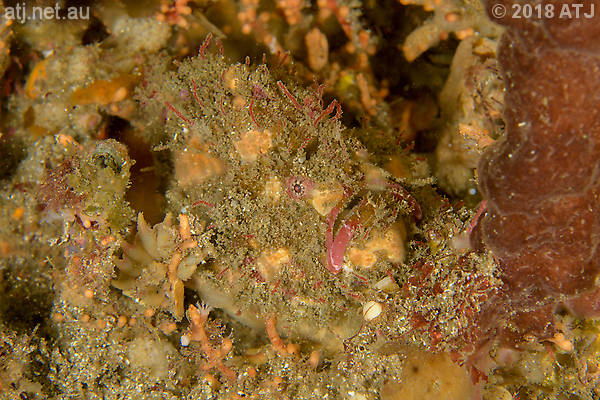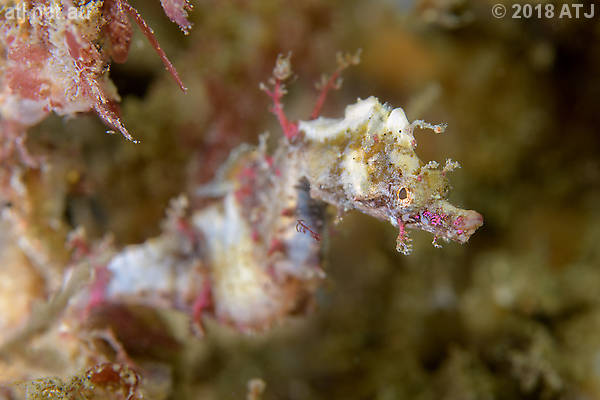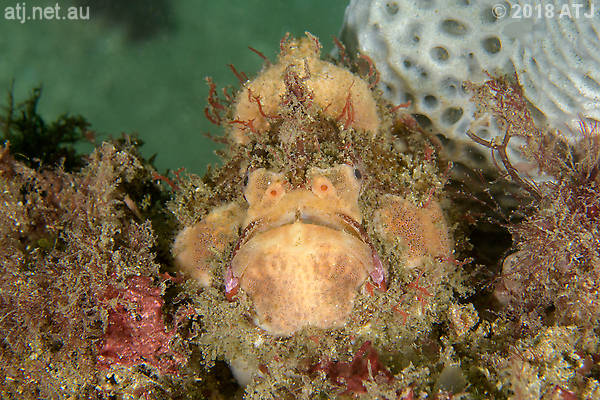Dive Details
Location
Date
Friday 9 February 2018
Time
12:15pm - 2:07pm
Details
Mike was going to come with me but had to pull out at the last minute so I dived on my own. I was keen to see how the eggs on "Clyde", the male weedy seadragon, were doing. It was calm at The Steps and the Leap had a rolling swell but nothing too large.
I got in from the low platform which just had the waves lapping over the top and swam out on the surface. The visibility was around 5 metres as I could see the bottom. I descended and headed at 30° to the sand line. I arrived just to the south-east of Lucy and Bob Rock. There was a lot of kelp stretching out over the sand. The visibility was around 10 metres and the water temperature around 17°C. There was only a gentle surge and no noticeable current. I turned left and headed for The Steps.
As I swam along the sand line I looked out at the kelp for weedy seadragons but found none. I swam past Seahorse Rock and on the flat rocks with sponges. "Clyde" wasn't under the overhang where he usually is but was out on the other side of the first flat rock. His eggs are developing nicely and I can just start to see some eyes. I fear I won't be able to dive at The Leap again before they hatch. I found the other male out on the sand, too. Ho no longer has any eggs.
I swam on past Bent Stick Rock and found a third weedy seadragon on the sand on the way to Southern Cross Rock, but just past the flat rock after Bent Stick Rock.
At Southern Cross Rock I first went up to look for the black painted anglerfish but I could not find it at all. I dropped down the side of the rock and found one whiteish male pygmy pipehorse. While I was looking for my pygmy pipehorses I spotted a well camouflaged orange red-fingered anglerfish next to the grey sponge where we've seen pygmy pipehorses before. I wonder how long it has been there and if I've missed it on previous dives.
I continued on to Seadragon Alley. Near the start I looked for the juvenile pygmy pipehorse. Not far in I came across a male weedy seadragon with new eggs. It was a surprise to find one so late in the season.
At the end of Seadragon Alley I looked for the two pygmy pipehorses that have been there for months. I could not find either of them. I was quite cold and not concentrating well. Perhaps I will find them next time. I looked on Sponge Rock for "Nina", the female great seahorse. I couldn't see her in the sponges but then I spotted her in the sea tulips. I swam down to the red pipefish and actually saw one right out of the alga from a few metres away. My the time I'd gotten ready to take photos I couldn't find it. I did find the darker one in the alga I'd seen the pair last time. I looked around the area and found the other one in an alga around a metre away. About this time the current increased and brought in dirty water that was warmer. The visibility dropped below 5 metres but the water was now around 18°C.
I swam up from the sand line towards the rock before Big Rock with the large red male pygmy pipehorse. The visibility seemed to be dropped as I approached the rock. It was now around 20°C but the visibility was down to 3 metres. I didn't initially find the large red male pygmy pipehorse but I did find one of the smaller ones in the same place it was yesterday. I then found the large male.
I swam on to Big Rock and did a circuit looking for pygmy pipehorse but found none. I dropped down to the rock below Hand Rock and found the now grey painted anglerfish on the substrate below the rock. He was flopping his lure around.
I continued along the reef to Old Basket Star Rock and then found the white male pygmy pipehorse that Mike had found yesterday. I looked around for a female or any others on the rock but found none.
I swam straight up to New Basket Star Rock and then down on the sand to the algae with the red Stigmatopora pipefish. There was still two there. Maybe Graham will actually get to see a pair.
I headed past Diversity Rock and on to the rock where I'd been seeing the red male pygmy pipehorse. I looked where it had been yesterday at the start of the dive but it was not there. I looked all around the sponges and I could not see it. Just then the current increased again but this time the water was very cold, back down to 17°C but it was cleared with the visibility increasing beyond 5 metres. I kept looking on the rock which was now difficult due the current and I spotted a tiny juvenile pygmy pipehorse floating over the rock. I attached itself and I was able to take photographs.
I drifted to the rock behind Little Big Rock and found the white male pygmy pipehorse in the same spot it was yesterday. After a bit of searching I found the juvenile pygmy pipehorse.
I continued along the reef looking for the missing anglerfishes. At the rock with the large orange finger sponge I found one of the Nembrotha purpureolineata I'd spotted yesterday. I couldn't find the other.
I kept looking around the rocks for anglerfishes when I finally spotted a medium sized orange painted anglerfish on a rock 5 metres or so from Di's Rock. I actually noticed it from some way back but wasn't 100% sure it was an anglerfish until I got closer.
From here I headed to the boulders, ascended to 5 metres and started my safety stop as I swam to Split Rock. The visibility dropped to around 3 metres in the shallower water but I was still able to navigate to Split Rock. I finished my safety stop and swam to the exit which was easy.
Seas
Some current and surge
Visibility
3 to 10 metres
Duration
111 minutes
Maximum depth
20.4 m
Average depth
14.2 m
Water temperature
16.7°C
Dive Profile from Citizen Hyper Aqualand

Tides at Botany Bay AEDT
Note that tides at dive site may vary from above location.
High
4:23am
1.42m
Low
10:59am
0.69m
High
4:44pm
1.15m
Low
10:37pm
0.65m
Camera gear
Camera
Nikon D500
Lens
Nikon AF-S Micro Nikkor 60mm f/2.8G ED
Housing
Ikelite 6812.5
Lens port
Ikelite Flat Port 5502.41
Strobe
2 x Ikelite SubStrobe DS161
Photographs
Depth information, where present, indicates the depth of the camera when the photograph was taken and can be used to approximate the depth of the subject.

Red-fingered angler, Porophryne erythrodactylus. 18 m.

Male Sydney pygmy pipehorse, Idiotropiscis lumnitzeri. 14 m.

Red-fingered angler, Porophryne erythrodactylus. 10.1 m.